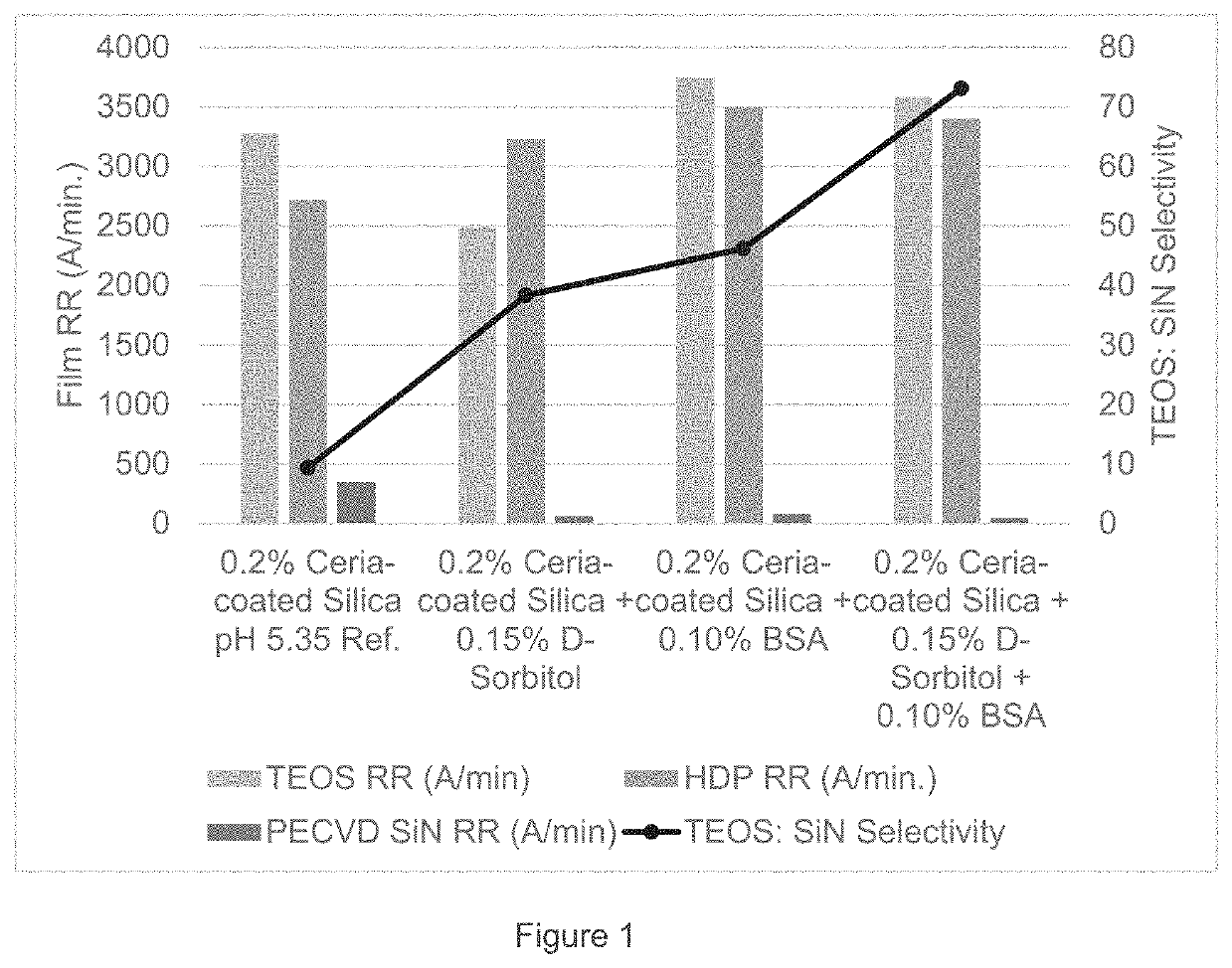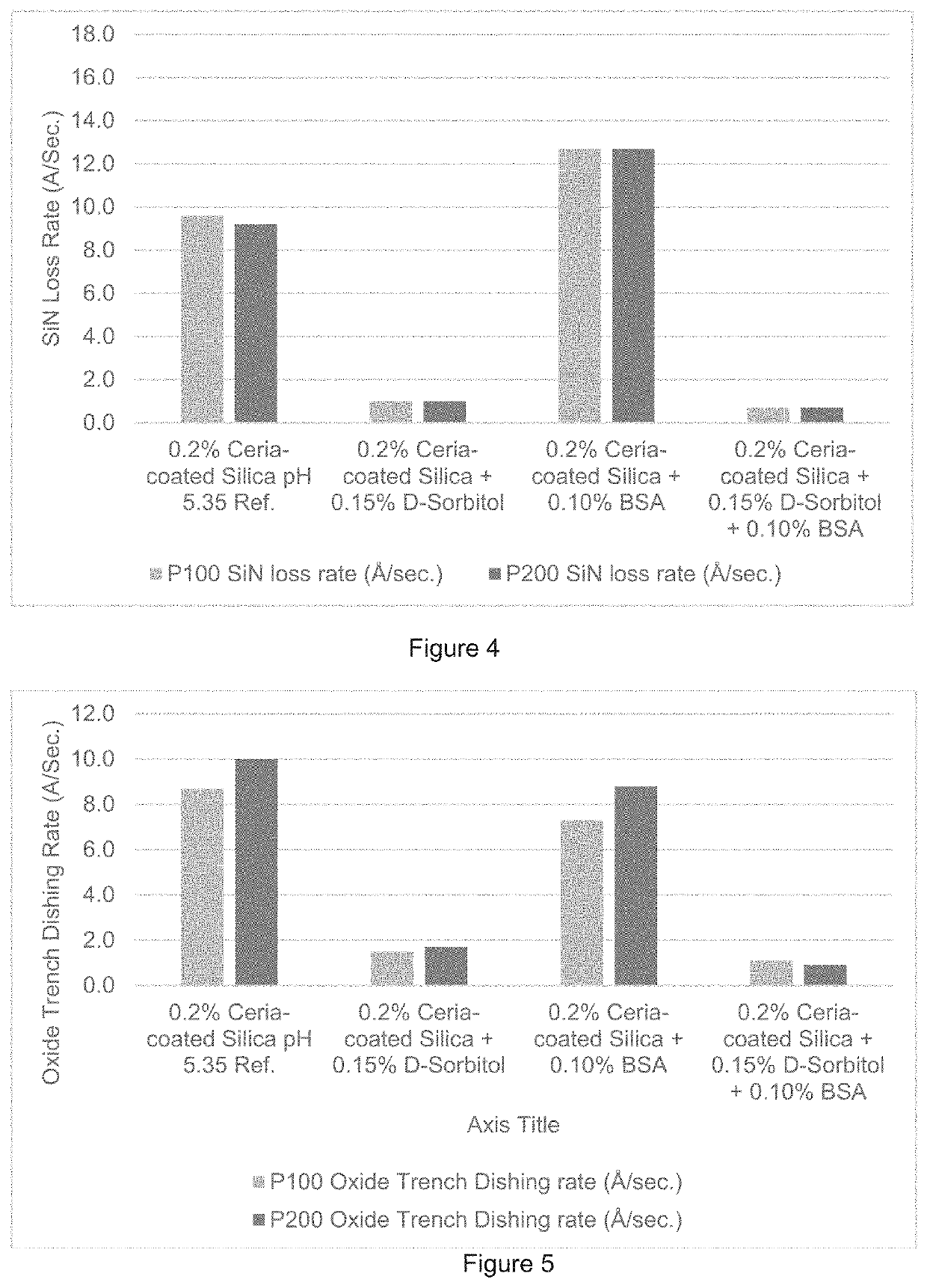Oxide Chemical Mechanical Planarization (CMP) Polishing Compositions
a chemical mechanical planarization and composition technology, applied in the direction of polishing compositions, other chemical processes, lapping machines, etc., can solve the problems of non-uniform trench oxide loss across dies, affecting transistor performance and device fabrication yields, device failure, etc., to suppress sin film removal, increase oxide film removal rate, increase teos: sin selectivity
- Summary
- Abstract
- Description
- Claims
- Application Information
AI Technical Summary
Benefits of technology
Problems solved by technology
Method used
Image
Examples
working examples
[0163]In the following working examples, a STI polishing composition comprising 0.2 wt. % cerium-coated silica particles, a biocide ranging from 0.0001 wt. % to 0.05 wt. %, and deionized water with pH being adjusted to 5.35 was prepared as reference(ref.) or other selected pH conditions.
[0164]The polishing compositions were prepared with the reference (0.2 wt. % cerium-coated silica, a biocide ranging from 0.0001 wt. % to 0.05 wt. %, and deionized water) and a first type of chemical additive or a second type of chemical additive or the mixed first type and second type of chemical additives with pH valued at 5.35 respectively or at other selected pH conditions.
example 1
[0165]In Example 1, the polishing compositions used for oxide polishing were shown in Table 1. The reference sample was made by using 0.2 wt. % ceria-coated silica particles, very low concentration of biocide, and DI water.
[0166]The first type of chemical additive, D-sorbitol, was used at 0.15 wt. % and mixed with reference sample.
[0167]The second type of chemical additive, benzenesulfonic acid, was used at 0.10 wt. % and mixed with reference sample.
[0168]The first type of chemical additive D-sorbitol was used at 0.15 wt. % and second type of chemical additive benzenesulfonic acid was used at 0.10 wt. % and mixed with reference sample.
[0169]All reference sample and testing samples had same pH values at around 5.35.
[0170]The removal rates (RR at Å / min) for polishing different films were tested. The effects of chemical additives on the film removal rates and TEOS: SiN film selectivity were observed and listed in Table 1 and depicted in FIG. 1.
TABLE 1Effects of Chemical Additives on Fi...
example 2
[0176]In Example 2, the polishing compositions used for polishing tests were shown in Table 2. The reference sample was made by using 0.2 wt. % ceria-coated silica particles, very low concentration of biocide, and deionized wafer at pH 5.35.
[0177]D-sorbitol or benzenesulfonic acid (BSA) was used alone or used together at 0.15 wt. % or 0.1 wt. % respectively in the testing samples.
[0178]All reference sample and testing samples had same pH values at around 5.35.
[0179]The effects of D-sorbitol or benzenesulfonic acid (BSA) or D-sorbitol+BSA on the oxide trenching dishing vs different over polishing times were tested and the results were listed in Table 2 and depicted in FIG. 2.
[0180]As the results shown in Table 2 and FIG. 2, the addition of first type of additive D-sorbitol as the chemical additive in the polishing composition reduced oxide trench dishing significantly vs different over polishing times while comparing the oxide trench dishing obtained vs different over polishing times...
PUM
| Property | Measurement | Unit |
|---|---|---|
| weight percent | aaaaa | aaaaa |
| pH | aaaaa | aaaaa |
| particle size | aaaaa | aaaaa |
Abstract
Description
Claims
Application Information
 Login to View More
Login to View More - R&D
- Intellectual Property
- Life Sciences
- Materials
- Tech Scout
- Unparalleled Data Quality
- Higher Quality Content
- 60% Fewer Hallucinations
Browse by: Latest US Patents, China's latest patents, Technical Efficacy Thesaurus, Application Domain, Technology Topic, Popular Technical Reports.
© 2025 PatSnap. All rights reserved.Legal|Privacy policy|Modern Slavery Act Transparency Statement|Sitemap|About US| Contact US: help@patsnap.com



